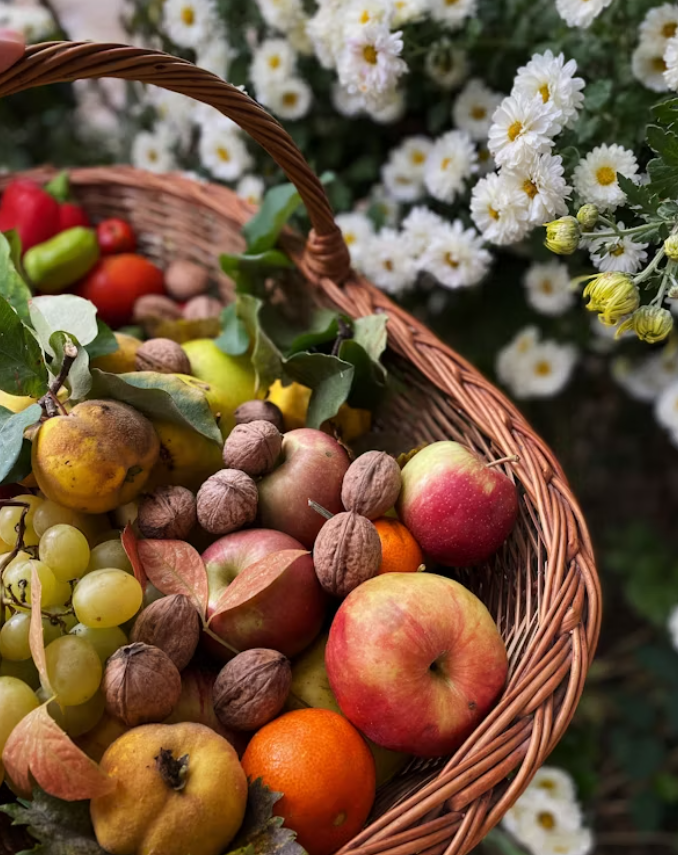1. Visit Farmers’ Markets
Farmers’ markets offer a great selection of fresh, local, and seasonal produce. Engage with farmers, ask about their harvesting practices, and learn about the best produce available.
2. Learn What’s in Season
Understanding what’s in season in your region helps you plan meals accordingly. For instance, spring brings asparagus and strawberries, summer offers tomatoes and zucchini, autumn highlights pumpkins and apples, and winter features root vegetables like carrots and sweet potatoes.

3. Look for Freshness Indicators
When selecting fruits and vegetables, check for vibrant colors, firm textures, and a fragrant aroma. Avoid produce with blemishes, mold, or an overly soft texture.
Simple and Flavorful Farm-to-Table Recipes
1. Spring Delight: Asparagus and Lemon Risotto
Ingredients:
- 1 cup Arborio rice
- 4 cups vegetable broth
- 1 bunch fresh asparagus, trimmed and chopped
- 1 small onion, finely chopped
- 1 clove garlic, minced
- ½ cup grated Parmesan cheese
- Zest and juice of 1 lemon
- 2 tbsp olive oil
- Salt and pepper to taste
Instructions:
- Heat olive oil in a pan, sauté onion and garlic until translucent.
- Add Arborio rice and toast for 1-2 minutes.
- Gradually add vegetable broth, stirring frequently until rice is cooked.
- Stir in asparagus, lemon zest, juice, and Parmesan.
- Season with salt and pepper, then serve warm.
2. Summer Freshness: Heirloom Tomato and Basil Salad
Ingredients:
- 3 large heirloom tomatoes, sliced
- 1 handful fresh basil leaves
- ¼ cup extra virgin olive oil
- 1 tbsp balsamic vinegar
- Salt and freshly ground black pepper
- ½ cup fresh mozzarella (optional)
Instructions:
- Arrange tomato slices on a plate.
- Sprinkle with basil leaves and mozzarella.
- Drizzle olive oil and balsamic vinegar over the top.
- Season with salt and pepper. Serve immediately.
3. Autumn Comfort: Roasted Pumpkin Soup
Ingredients:
- 1 small pumpkin, peeled and cubed
- 1 small onion, chopped
- 2 cloves garlic, minced
- 4 cups vegetable broth
- ½ cup coconut milk
- 1 tsp ground cinnamon
- ½ tsp ground nutmeg
- 2 tbsp olive oil
- Salt and pepper to taste
Instructions:
- Preheat oven to 400°F (200°C). Toss pumpkin with olive oil, salt, and pepper, then roast for 25 minutes.
- In a pot, sauté onion and garlic. Add roasted pumpkin and vegetable broth.
- Simmer for 10 minutes, then blend until smooth.
- Stir in coconut milk, cinnamon, and nutmeg. Serve hot.
4. Winter Warmth: Root Vegetable Hash
Ingredients:
- 1 sweet potato, diced
- 1 carrot, diced
- 1 parsnip, diced
- 1 small onion, chopped
- 2 tbsp olive oil
- 1 tsp smoked paprika
- 2 eggs (optional)
- Salt and pepper to taste
Instructions:
- Heat olive oil in a pan, sauté onion until golden.
- Add root vegetables and cook until tender.
- Sprinkle with smoked paprika, salt, and pepper.
- Serve as is or top with a fried egg for added richness.
Tips for Incorporating Farm-to-Table in Everyday Cooking
1. Plan Your Meals Around Seasonal Produce
Base your weekly menu on what’s available at the market, making it easier to enjoy the freshest ingredients.
2. Preserve Seasonal Bounty
Freezing, pickling, or fermenting excess produce allows you to enjoy seasonal flavors year-round.
3. Grow Your Own Herbs and Vegetables
Even if space is limited, container gardening lets you cultivate fresh herbs and small vegetables like cherry tomatoes or peppers.
Conclusion
Embracing the farm-to-table lifestyle means celebrating the best that each season has to offer. With fresh, locally sourced ingredients, you can create simple yet delicious meals that nourish both body and soul. Whether you’re indulging in a refreshing summer salad or a hearty winter soup, seasonal cooking brings unmatched flavors to the table. Start today by visiting your local farmers’ market, selecting the freshest produce, and savoring the vibrant tastes of each season.
FAQs
1. What does farm-to-table mean?
Farm-to-table refers to sourcing food directly from local farms, ensuring fresher, seasonal, and sustainable ingredients.
2. How can I tell if produce is truly fresh?
Look for vibrant colors, firm textures, and a natural aroma. Avoid items that appear wilted or overly soft.
3. Is farm-to-table more expensive than grocery store shopping?
Not necessarily. Seasonal produce is often more affordable due to its abundance, and direct purchases from farmers eliminate middlemen costs.
4. Can I practice farm-to-table in urban areas?
Yes! Many cities have farmers’ markets, community-supported agriculture (CSA) programs, and urban gardens to provide fresh local produce.
5. How do I start a farm-to-table lifestyle?
Begin by shopping at local farmers’ markets, learning about seasonal produce, and cooking with fresh, whole ingredients.
4o
No responses yet